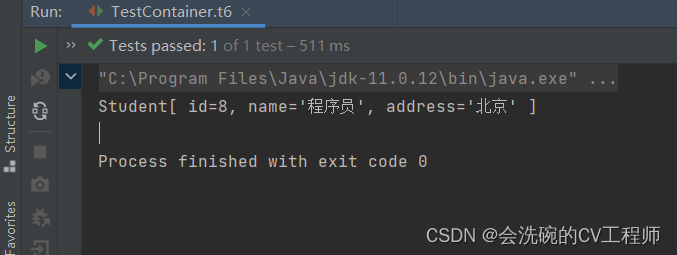Spring DI简介及依赖注入方式和依赖注入类型
目录
一、什么是依赖注入
二、依赖注入方式
1. Setter注入
2. 构造方法注入
3. 自动注入
三、依赖注入类型
1. 注入bean类型
2. 注入基本数据类型
3. 注入List集合
4. 注入Set集合
5. 注入Map集合
6. 注入Properties对象
往期专栏&文章相关导读
1. Maven系列专栏文章
2. Mybatis系列专栏文章
3. Spring系列专栏文章
一、什么是依赖注入
依赖注入(Dependency Injection,简称DI),它是Spring控制反转思想的具体实现。
控制反转将对象的创建交给了Spring,但是对象中可能会依赖其他对象。比如service类中要有dao类的属性,我们称service依赖于dao。之前需要手动注入属性值,代码如下:
public interface StudentDao {
Student findById(int id);
}
public class StudentDaoImpl implements StudentDao{
@Override
public Student findById(int id) {
// 模拟根据id查询学生
return new Student(1,"程序员","北京");
}
}
public class StudentService {// service依赖dao,手动注入属性值,即手动维护依赖关系
private StudentDao studentDao = new StudentDaoImpl();
public Student findStudentById(int id){
return studentDao.findById(id);
}
}
此时,当StudentService的想要使用StudentDao的另一个实现类如StudentDaoImpl2时,则需要修改Java源码,造成代码的可维护性降低。
而使用Spring框架后,Spring管理Service对象与Dao对象,此时它能够为Service对象注入依赖的Dao属性值。这就是Spring的依赖注入。简单来说,控制反转是创建对象,依赖注入是为对象的属性赋值
二、依赖注入方式
1. Setter注入
被注入类编写属性的setter方法
public void setStudentDao(StudentDao studentDao){this.studentDao = studentDao;}
配置文件中,给需要注入属性值的 <bean> 中设置 <property>
<bean id="studentDao" class="com.itbaizhan.dao.StudentDaoImpl"> </bean>
<bean id="studentService" class="com.itbaizhan.service.StudentService"><!--依赖注入--><!--name:对象的属性名 ref:容器中对象的id值--><property name="studentDao" ref="studentDao"></property>
</bean>
测试
新增测试方法
// 测试依赖注入@Testpublic void t6(){ApplicationContext ac = new ClassPathXmlApplicationContext("bean.xml");StudentService service = (StudentService) ac.getBean("studentService");System.out.println(service.findStudentById(8));}运行结果

OK,确实成功测试到了
2. 构造方法注入
被注入类编写有参的构造方法
public StudentService(StudentDao studentDao){this.studentDao = studentDao;}
给需要注入属性值的 <bean> 中设置 <constructor-arg>
<bean id="studentDao" class="com.itbaizhan.dao.StudentDaoImpl"></bean>
<bean id="studentService" class="com.itbaizhan.service.StudentService"><!-- 依赖注入 --><!-- name:对象的属性名 ref:配置文件中注入对象的id值 --><constructor-arg name="studentDao" ref="studentDao"></constructor-arg>
</bean>测试结果:

OK,确实也是可以使用的
3. 自动注入
自动注入不需要在 <bean> 标签中添加其他标签注入属性值,而是自动从容器中找到相应的bean对象设置为属性值。
自动注入有两种配置方式:
- 全局配置:在 <beans> 中设置 default-autowire 属性可以定义所有bean对象的自动注入策略。
- 局部配置:在 <bean> 中设置 autowire 属性可以定义当前bean对象的自动注入策略。
autowire的取值如下:
- no:不会进行自动注入。
- default:全局配置default相当于no,局部配置default表示使用全局配置
- byName:在Spring容器中查找id与属性名相同的bean,并进行注入。需要提供set方法。
- byType:在Spring容器中查找类型与属性类型相同的bean,并进行注入。需要提供set方法。
- constructor:在Spring容器中查找id与属性名相同的bean,并进行注入。需要提供构造方法。
三、依赖注入类型

DI支持注入bean类型、基本数据类型和字符串、List集合、Set集合、Map集合、Properties对象类型等,他们的写法如下:
准备注入属性的类
package com.example.service;import com.example.dao.StudentDao;
import com.example.pojo.Student;import java.util.List;
import java.util.Map;
import java.util.Properties;
import java.util.Set;public class StudentService {// service依赖dao,手动注入属性值,即手动维护依赖关系//private StudentDao studentDao;// bean属性private StudentDao studentDao;// 字符串类型private String name;// 基本数据类型private int count;// 字符串List集合private List<String> students1;// 对象类型List集合private List<Student> nameList;// 字符串类型Set集合private Set<String> students2;// 字符串类型Map集合private Map<String, String> students3;// 对象类型map集合private Map<String,Student> studentMap;// Properties类型private Properties properties;public StudentService(){}public StudentService(StudentDao studentDao){this.studentDao = studentDao;}public Student findStudentById(int id){return studentDao.findById(id);}public void setStudentDao(StudentDao studentDao){this.studentDao = studentDao;}public StudentDao getStudentDao() {return studentDao;}public String getName() {return name;}public void setName(String name) {this.name = name;}public int getCount() {return count;}public void setCount(int count) {this.count = count;}public List<String> getStudents1() {return students1;}public void setStudents1(List<String> students1) {this.students1 = students1;}public Set<String> getStudents2() {return students2;}public void setStudents2(Set<String> students2) {this.students2 = students2;}public Map<String, String> getNames2() {return students3;}public void setNames2(Map<String, Student> names2) {this.studentMap = names2;}public Map<String, String> getStudents3() {return students3;}public void setStudents3(Map<String, String> students3) {this.students3 = students3;}public Properties getProperties() {return properties;}public void setProperties(Properties properties) {this.properties = properties;}public List<Student> getNameList() {return nameList;}public void setNameList(List<Student> nameList) {this.nameList = nameList;}@Overridepublic String toString() {return "StudentService[ " +"studentDao=" + studentDao +", name='" + name + '\'' +", count=" + count +", students1=" + students1 +", nameList=" + nameList +", students2=" + students2 +", students3=" + students3 +", studentMap=" + studentMap +", properties=" + properties +" ]";}
}
准备测试方法
// 测试注入类型@Testpublic void t7(){ApplicationContext ac = new ClassPathXmlApplicationContext("bean.xml");StudentService service = (StudentService) ac.getBean("studentService");System.out.println(service);}1. 注入bean类型
<!-- 注入bean类型 --><bean id="studentDao" class="com.example.dao.StudentDaoImpl1"/><!-- 写法1 --><bean id="studentService" class="com.example.service.StudentService"><property name="studentDao" ref="studentDao"/></bean><!-- 写法2 --><!--<bean id="studentService" class="com.example.service.StudentService"><property name="studentDao"><ref bean="studentDao"/></property></bean>-->2. 注入基本数据类型
<!-- 注入基本数据类型 --><!-- 写法一 name:属性名 value:属性值 --><property name="name" value="程序员"/><!-- 写法二 name:属性名 value:属性值--><property name="count"><value>10</value></property>3. 注入List集合
<!-- 注入List集合 --><!-- 简单的数据类型List集合 name:属性名 --><property name="students1" ><list><value>上海</value><value>广州</value></list></property><!-- 对象类型的List集合 name:属性名 --><property name="nameList"><list><bean class="com.example.pojo.Student"><property name="id" value="1"/><property name="name" value="几何心凉"/><property name="address" value="北京"/></bean><bean class="com.example.pojo.Student"><property name="id" value="2"/><property name="name" value="哈士奇"/><property name="address" value="上海"/></bean></list></property>4. 注入Set集合
<!-- 注入Set集合 --><property name="students2"><set><value>深圳</value><value>北京</value></set></property>5. 注入Map集合
<!-- 注入Map集合 --><property name="students3"><map><entry key="哈士奇" value="上海"/><entry key="几何心凉" value="北京"/></map></property><!-- 注入对象类型map类型 --><property name="names2"><map><entry key="student1" value-ref="s1"/><entry key="student2" value-ref="s2"/></map></property> <bean id="s1" class="com.example.pojo.Student"><property name="id" value="1"/><property name="name" value="几何心凉"/><property name="address" value="北京"/></bean><bean id="s2" class="com.example.pojo.Student"><property name="id" value="2"/><property name="name" value="哈士奇"/><property name="address" value="上海"/></bean>上面是用到的bean对象
6. 注入Properties对象
<!-- 注入properties --><property name="properties"><props><prop key="配置1">值1</prop><prop key="配置2">值2</prop></props></property>运行测试方法测试一下

OK ,可以看到都是插入的了。
往期专栏&文章相关导读
大家如果对于本期内容有什么不了解的话也可以去看看往期的内容,下面列出了博主往期精心制作的Maven,Mybatis等专栏系列文章,走过路过不要错过哎!如果对您有所帮助的话就点点赞,收藏一下啪。其中Spring专栏有些正在更,所以无法查看,但是当博主全部更完之后就可以看啦。
1. Maven系列专栏文章
| Maven系列专栏 | Maven工程开发 |
| Maven聚合开发【实例详解---5555字】 |
2. Mybatis系列专栏文章
| Mybatis系列专栏 | MyBatis入门配置 |
| Mybatis入门案例【超详细】 | |
| MyBatis配置文件 —— 相关标签详解 | |
| Mybatis模糊查询——三种定义参数方法和聚合查询、主键回填 | |
| Mybatis动态SQL查询 --(附实战案例--8888个字--88质量分) | |
| Mybatis分页查询——四种传参方式 | |
| Mybatis一级缓存和二级缓存(带测试方法) | |
| Mybatis分解式查询 | |
| Mybatis关联查询【附实战案例】 | |
| MyBatis注解开发---实现增删查改和动态SQL | |
| MyBatis注解开发---实现自定义映射关系和关联查询 |
3. Spring系列专栏文章
| Spring系列专栏 | Spring IOC 入门简介【自定义容器实例】 |
| IOC使用Spring实现附实例详解 | |
| Spring IOC之对象的创建方式、策略及销毁时机和生命周期且获取方式 | |
| Spring DI简介及依赖注入方式和依赖注入类型 | |
| Spring IOC相关注解运用——上篇 | |
| Spring IOC相关注解运用——下篇 | |
| Spring AOP简介及相关案例 | |
| 注解、原生Spring、SchemaBased三种方式实现AOP【附详细案例】 | |
| Spring事务简介及相关案例 | |
| Spring 事务管理方案和事务管理器及事务控制的API | |
| Spring 事务的相关配置、传播行为、隔离级别及注解配置声明式事务 |
